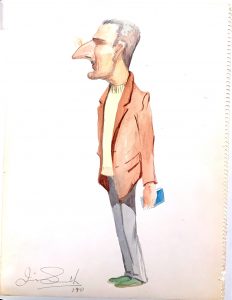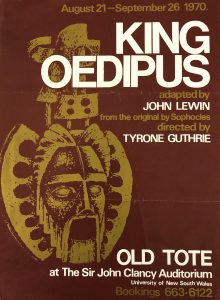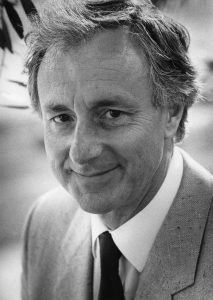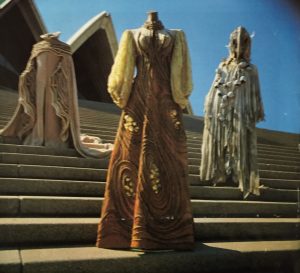The first part of this blog generated irresistible questions. Why was Sir Tyrone Guthrie (1900-1971) such a towering figure? Why was he obsessed with Oedipus? Why was there such a mixed reaction to the local production? And what sources lead to a deeper understanding of Guthrie’s contribution to theatre, particularly in Australia?
Guthrie

Sir Tyrone Guthrie’s career began in 1924 at the BBC, where he produced plays for radio. During the 1920s and 1930s, he developed his craft with stints at the Scottish National Players, Cambridge Festival Theatre, and, notably, in leadership roles at the Shakespeare Repertory Company, Old Vic and Sadler’s Wells. His reputation grew internationally with work on West End and Broadway and with the Metropolitan Opera in New York. He produced plays for the Edinburgh Festival 1948-52, when his hallmark thrust stage first proved its worth. He became founding artistic director of the Strathfield Festival of Canada in 1952. His campaign for the development of repertory theatre in the United States, from 1956 to 1963, led to the establishment of the Guthrie Theatre at University of Minnesota, Minneapolis, where he served as artistic director from 1963 to 1966.
He left behind a reputation as a commanding, congenial and collegial director. It has been said that he hated self-importance and pomposity. Although he was firm there was lots of laughter in his company. Lilian Baylis, the English theatrical producer and director, once said he had a mind like a crystal and the heart of a child. University of New South Wales electrician Jim Smith may have captured these qualities in a caricature created when Guthrie was on campus.
He thought of the producer as a conductor. Toscanini was one of his heroes. He often used musical terms in directing players – ‘More brio, Chris! … in crescendo, crowd, please! … Pianissimo! Patricia’ – a style noted by some of the Australian actors who came under his spell. He didn’t tell the actors directly what to do. He wanted the answers to come from them. He liked rebellious actors, but he wanted them to consider the audience without being self-indulgent. At Stratford in Ontario, he would work on one of his productions by “making, breaking, re-making, nothing too set till the right moment, leading up to the crux of completion on the day, and only on the day.”
He had a respect for amateur and student theatre. According to his biographer John Forsyth: “From Cambridge on, there were no ‘extras’ no ‘walk-ons’, they were all players, all essential to the play – no matter how small the part”. His companies made chemistry out of ‘the Guthrie mixture’ – a combination of professional, amateur and small-part players who have never seen a stage or studio in their lives before.”
He had a strong connection with many universities. He wanted to connect academic theatre to professional, regional, repertory theatre. In many respects, he personified university strategies based on academic excellence, social engagement and global impact. He served as Professor of Speech and Drama at Minnesota and, in 1963, was elected Chancellor of Queen’s University, Belfast.
There were notable university connections in Australia. After his first visit, in 1949, to report on Australia’s readiness for a national theatre, he visited again at the invitation of Professor Fred Alexander to advise on the construction of the Octagon Theatre at the University of Western Australia. His relations with Professor Robert Quentin in Sydney and John Sumner in Melbourne can also be factored into his global influence on the role of universities as catalysts for professional theatre companies.
King Oedipus

Guthrie became acquainted with Sophocles’ Oedipus in 1924, when he performed the role of Teiresias for the Oxford Players, a performance that attracted this praise from a critic: ‘The outstanding performance of the evening was certainly that of Mr Tyrone Guthrie as Teiresias; he alone of the players raised the drama to real heights of tragedy and passion… he was Teiresias.”
He regarded the play as the greatest ever written partly because of its philosophical puzzles. Its central question – Who am I? – is one that many starting university studies carry with them on their first day. The puzzle of why Oedipus, a good man, was torn apart invites reflections on how the good are sometimes punished and the bad are sometimes rewarded. And it provokes thinking about evolving taboos in society, incest in this case.
He considered Oedipus a universal drama combined all the arts. It was a belief reinforced by his productions of the play in different languages – for the Habimah production in Palestine, for the Swedish Theatre in Helsinki and for the Stratford Festival Theatre in Ontario.
His affinity with the play was more than intellectual. Oedipus means swollen foot. In his teens, Guthrie had one of his toes amputated. Thereafter he preferred sneakers and sandals to other types of footwear. He was close to his mother and had a distant relationship with his father. He had read Freud and consulted the neurologist and psychoanalyst Earnest Jones about Hamlet and Oedipus. John Lewin, who wrote the version of the play for Australia, was convinced that his fourth production was to be, for Guthrie, ‘a deeply personal and valedictory statement – if spared.’
University of New South Wales resonances

The music for the production was composed by the late Roger Covell, who died in June 2019. Covell established music as a discipline at the University of NSW in 1966, formed the UNSW Opera in 1968, and co-founded the Australia Ensemble, the resident UNSW chamber group. His landmark book, Australia’s Music: Themes of a New Society was published in 1967.
In 1970, Covell’s report, Music in Australia: Needs and Prospects, written with Patricia Brown and Margaret Sargent on behalf of Unisearch Limited at UNSW and the Australian Council of the Arts, recommended, among other suggestions, that libraries of the performing arts be established at the Sydney Opera House and other performing arts centres then under construction or being planned.
The Dennis Wolanski Library and Archives of the Performing Arts was established three years later, in May 1973.

Four months after the launch of the library, King Oedipus went to the Sydney Opera House. In September 1973, the University of New South Wales played an important role in presenting the first exhibition at the Sydney Opera House, All the World’s a Stage. Organised by the Sydney Opera House Trust, British Council and Australian UNESCO Committee for the Arts, with the support of John Fairfax and Sons Limited, the Australian Elizabethan Theatre Trust and British Airways, the exhibition ran from September to October 1973.
UNSW Vice-Chancellor Sir Philip Baxter was at that time also Chairman of the Sydney Opera House Trust. Professor Robert Quentin from the UNSW School of Drama served on the organising committee. Dr Margaret Williams undertook much of the research for the Australian content. Her article The Australian Theatre was published in the exhibition catalogue, together with articles on the early history of the English theatre by Professor GWG Wickham and on the later history of the English theatre by GR Rowell.
Among the 285 exhibits were the masks and costumes for Teiresias, Oedipus and Jocasta, the set model designed by Yoshi Tosa and the platform shoes worn by Ron Haddrick and Ruth Cracknell.
The remains of the production
When the production ended its tour of Australia in 1971, Ruth Cracknell, who had performed the role of Jocasta, wrote in her biography. “So the costumes, the masks, the boots were finally packed away. The great beings disappeared into a wardrobe skip. I just hope someone has had the sense to keep them.”
Indeed, costumes, records and other sources were kept but they are now scattered. Tracking them down has been rewarding because it has helped us gain a better understanding of what happened. The process has emphasised the important work of libraries, archives, museums, theatre companies, cultural centres and scholars in preserving and making accessible the history. But it has also brought to the surface cultural heritage anomalies. Institutional heritage policies change over time and are sometimes open to idiosyncratic personal interpretation. Mistakes are made and can be perpetuated in cataloguing systems. Despite powerful tools such as Trove, AusStage and AustLit, there are challenges in finding material and pulling the threads of a story together.
Production records, photographs, costumes and oral history recordings
The Old Tote Theatre Company production and administrative records are held in the National Institute of Dramatic Art Archives. These include correspondence files, schedules, salaries, budgets, stage layouts in various venues, stage manager reports, understudy lists, call sheets, lighting and lamp settings, account records with box office takings and a prompt book with minimal directions. There is also a collection 23 contact prints with 600 high quality photographs showing the production unfolding under the guidance of Guthrie.
The NIDA collection also has a selection of masks and costumes, including one Teiresias mask, possibly a rehearsal mask, but not the costumes, masks, accessories, and platform boots that travelled to the Sydney Opera House.
The platform boots – or kothurni – were important. Richard Wherrett, who observed and made notes on the King Oedipus production, has written about the need for lengthy practice to get used to them. In 1977, the use of platform boots caused backstage tensions at the Sydney Conservatorium in the Stravinsky opera, Oedipus Rex. The Australian King Oedipus actors had just three weeks. As objects, they enhance our understanding of Greek tragedy and the practical aspects of applying a tradition.
The Oedipus mask worn by Ron Haddrick ended up at the Museum of Applied Arts and Sciences, but the whereabouts of the Teiresias mask and costume, the Oedipus chest decoration and the platform boots worn by the two main characters remain a mystery. “Where’s Teiresias?” is a question the detectives in our team are working to answer.
The records in the NIDA archive have been joined by two special collections and documentary endeavours.
Yoshi Tosa’s personal collection of costume and set designs for the company 1968-1975 includes 12 costume and mask designs for the Oedipus production, important elements in any future exhibition.
Margaret Leask’s oral histories, conducted on behalf of NIDA, include recorded interviews with the late Ron Haddrick, Ronald Falk and Yoshi Tosa. Ruth Cracknell recorded an interview with by Michelle Potter for the National Library of Australia in which she comments on the Oedipus production.
Among some other material, the UNSW Sydney Archives holds several arresting photos of the 1970 King Oedipus production, some of which were published in the first part of this blog.
Programs, posters, flyers, clippings can be found in several collections, including NIDA, the Dennis Wolanski Library collection at UNSW, the State Library of NSW and National Library of Australia.
Video recordings
The opening moments of the production in the Clancy auditorium, the rehearsals and other moments in the production were captured in the ABC Chequerboard program I Think Perhaps I Wanted to Hide in the Theatre. This was an important discovery because it helped us get closer to Guthrie – to show him at work on the ‘moulding, shaping’ process. A copy of the video has now been deposited in the UNSW Archive for research purposes
Clips from this production can also be seen in It’s Ruth: Ruth Cracknell, Actor (1994), available in Australian Screen Online at the National Film and Sound Archive. After Guthrie had returned to Ireland in 1970, a BBC team had turned up to do a documentary on Sir Tyrone Guthrie, his way of life and the jam factory, a business investment of Guthrie endeavouring to help unemployed youth in the area. This is an aspect of the Guthrie story that deserves attention on another occasion.
Commentary
James Forsyth’s biography of Tyrone Guthrie, Ruth Cracknell’s A Biased Memoir and Richard Wherrett’s The Floor of Heaven are among published recollections that offer first-hand commentary on Guthrie and the Oedipus production.
Reviews and clippings capture the immediate impressions of a mixed bag of commentators. Forsyth, in his book, characterised the first night critics at the UNSW as philistines, before concluding that the “philistines were defeated, the play ran and grew to resounding critical acclaim”. He quotes a review Guthrie’s Oedipus Fulfills All Hope: “The production will set a standard by which others will measured. See it!” But he doesn’t cite the author and source.
There is a swag of clippings in the Dennis Wolanski Library collection in UNSW and in the Old Tote Theatre collection at NIDA. Some reviews of the Sydney performances were quoted in the first part of this blog. Leonard Radic, reviewing a performance at the Princess Theatre, Melbourne, described it as a “bleak, sombre, ritualistic production, which, from its smoky start to its quite solemn finish, is utterly compelling… Those who appreciate good theatre, as distinct from easy entertainment, should see it”. On the other hand, Gerald Mayhead, in Tragedy Without Tears, wrote “Tyrone Guthrie’s production of theatre’s most perfect tragedy touches the intellect without ever touching the heart, and so leaves its audience wiser if unmoved.” For one reviewer, the production sang in a theatre which Guthrie helped design, the Octagon Theatre at the University of Western Australia.
What does the journey of the play across Australia tell us about Australian critics, Australian audiences and their tastes in 1970? Guthrie, after all, had said in his autobiography, A Life in the Theatre: “No amount of money can persuade an audience sincerely to enjoy what is not to its taste. And I maintain that without their spontaneous sincere appreciation, without the proper relation between stage and audience, no production can come fully to life.” Performances can respond to the nature of a space, the nature of the audience and unpredictable chemistry on the night.
They are questions at the heart of our research project at the UNSW, Repertoire: Sydney Performances 1920-2020.
Unexpected connections
Guthrie’s visit to Australia in 1970 nearly didn’t happen. Just before Christmas in 1969, following his work on Uncle Vanya for the Guthrie Theatre in Minneapolis, he had a severe heart attack, his second within a decade. The doctors had recommended no more work and physical activity. Mortality was now very much on his mind.
He contemplated retirement and, in taking stock of his life, he wanted to learn more about his family history, particularly the line that led to Tyrone Power I (1797-1841), the Irish prince of actors, who had disappeared in the Atlantic Ocean. It was an interest stimulated by a visit from the author and theatre historian Mildred Stock, who was working on the life of Tyrone Power.
It seems likely that Guthrie did not know, when he was at the University of New South Wales, that one of his forebears, the musician Lewis Lavenu, was buried a stone’s throw away at Camperdown cemetery and that Lavenu had been involved in Australian theatre during the 1850s.
Lavenu was the father of Guthrie’s great aunt Ethel, the grandmother of the Hollywood actor Tyrone Power. In 1840, Lavenu had arranged tours of Franz Liszt in the British Isles. In 1846, his grand opera Loretta: A Tale of Seville premiered at Drury Land Theatre, London. He had first arrived in Australia in 1853 and worked as a teacher and accompanist with the Australian singer Marie Carandini, the great grandmother of another British actor, Sir Christopher Lee.
In July 1859, Lavenu conducted a choir of 250 and an orchestra of 50 in performances of Handel’s Messiah and Haydn’s The Creation during a 5-day music festival celebrating the opening of the Great Hall at the University of Sydney. He was simultaneously working at the 3000-seat ill-fated Prince of Wales Theatre that had opened on Castlereagh Street in 1855. He appears to have been working at the time on arrangements for the operas Rigoletto, Traviata and Ernani. After a short, and unexpected illness he died on 1 August 1859. The Prince of Wales Theatre closed for the night. The afternoon performance in the Botanical Gardens by the Band of the 12th Regiment in the Botanical Gardens was cancelled.
Lavenu was remembered for his urbanity, kindliness of manner and dedication to work, despite a sudden illness at the time of the University of Sydney festivities. Guthrie was similarly possessed, “determined to pursue his policy of dying in harness”. After returning from Australia, he had started rehearsals for the opera, The Barber of Seville at the Theatre Royal, Brighton. He was contemplating yet another production of Oedipus for the Phoenix Theatre in New York. There were tensions over his failing investment in the Jam Factory. He died on 15 May 1971 after sitting down to answer mail.
Reviving memories
The Performance Memories Project, currently focusing on organising and making accessible the extensive Wolanski Library collection at the UNSW is developing plans to link the collection to AusStage and Trove to support research at the university and further afield. If you are aware of additional material, we would love to hear from you
Author
Paul Bentley is assisting the Performance Memories Project to improve the accessibility of the Wolanski collection in the UNSW Library. He saw the production in the Sir John Clancy Auditorium, looked after some of the masks and costumes from 1973 to 1997, and performed the role of Teiresias for the WEA Studio Theatre, Newcastle, in 1967.
Pingback: When Sir Tyrone Guthrie launched the Sir John Clancy Auditorium, part 1 – Performance Memories